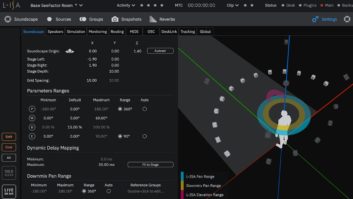Why the world needs another optical compressor remained a mystery until I tried Pendulum Audio’s OCL-2. I used the 2-channel OCL-2 as a vocal compressor on several gigs that I mixed, including John Prine and several dozen bands at the Portland Blues Festival the following week.
But first, some background. VCA compressors, especially common in live sound, achieve accurate compression ratios with well-defined thresholds. A chart of a VCA’s gain response shows a 45degrees slope (1:1, or unity gain), a bend at the threshold of compression, and a second, flatter straight line whose slope is determined by the ratio. Many VCA-based compressors also have employed soft-knee features that allow a smoother transition into compression, illustrated by a rounding of the intersection of these two slopes.
An optical compressor uses a photo-attenuator, whose resistance changes with the light intensity but cannot respond as quickly as the light. Vintage models like the LA-2A use an electro-luminescent panel shining on a light-sensitive semiconductor. The LA-2A’s classic soft-knee response is a result of level detection from this circuit’s output (feedback detection), instead of the input (feed-forward) detection used in VCA compressors. Unlike a VCA’s clinical compression slope with a fixed ratio, the response of an optical compressor moves through a soft-knee at threshold, reaches a plateau of compression at the target ratio, and gradually makes a transition to higher ratios of compression. As a signal leans into it harder, these increasing ratios add a “density” to the sound that is pleasing to the ear.
The Pendulum OCL-2 uses a proprietary method for enhancing the response of a modernized version of this mechanism, providing faster attack and release times than are available from traditional optical compressors, and offering unrivaled transparency in its fastest settings. I usually find optical compressors a bit dull and woolly for live sound, where clarity and presence are paramount for lead vocals to stand out in the mix, but the OCL-2’s performance on vocals is bound to earn it a place in the outboard racks of top tours. On its first outing, the Pendulum’s open, clear sound earned many compliments, with an almost embarrassing series of audience members lining up to praise the sound at the end of the show.
In Fast mode the OCL-2 performs a peak averaging of the signal and offers a very open sound. This is the best setting for live work, and is even faster than the fastest manual settings. Six other presets, generally intended for studio applications, are similar to those found on original Fairchild compressors. Four of these have increasingly slower attack and longer release times, with each letting a more dynamic range punch through. Preset 5 has a program-dependent release time emulating the LA-2A’s two-stage release. Preset 6 is also program-dependent, but with three release stages. Both of these presets are useful for full-program mastering or vocal tracking, when the engineer doesn’t want the compressor to “suck back to zero” immediately.
The optical compressor section is followed by a Class A, transformerless tube amplifier. Class A circuitry eliminates the crossover distortion found in push-pull output stages, and the omission of a transformer offers an uncolored signal. Though not recommended for best performance, the OCL-2 can be ordered with optional Jensens for applications where galvanic isolation is desired. The transformerless OCL-2 reviewed was unbalanced, with both 11/44-inch and XLR connections, but it worked problem-free with standard balanced cables.
The OCL-2 also has side-chain access on a TRS 11/44-inch jack for inserting an EQ to allow frequency-tailored compression. Pendulum also supplied 6dB/octave highpass filters cleverly built into the back-shells of TRS jacks to take advantage of this “open architecture.” These highpass filters inserted in the side-chain reduced the proximity-effect dominance of the compressor’s action in close-miked live vocals, and opened up the compressor’s sound further.
With large VU meters, this blue-faced, two-space unit has the classic look of its genre. These hand-built gems employ poly caps, metal-film resistors and single-sided audio PC boards. When turned on, the tube’s power supplies gently ramp up to extend their life, and after taking a couple of minutes to warm up, relays un-mute the outputs.
Though the name Pendulum is relatively unknown, the exquisite craftsmanship in the OCL-2 is reminiscent of the company’s audiophile SPS-1 acoustic instrument preamps, which have found their way into the racks of top players like James Taylor, Leo Kottke and David Wilcox. Two other Pendulum products were also introduced at the recent AES convention-the MDP-1 Tube Mic/DI Preamp and the 6386 Variable Mu Tube Limiter.
Pendulum Audio, P.O. Box 339, Gillette, NJ 07933; 908/665-9333; www.pendulumaudio.com.





